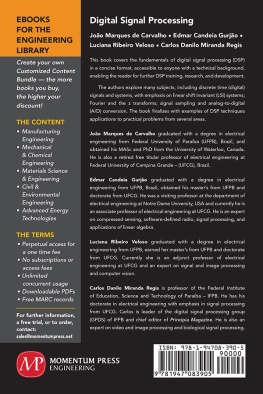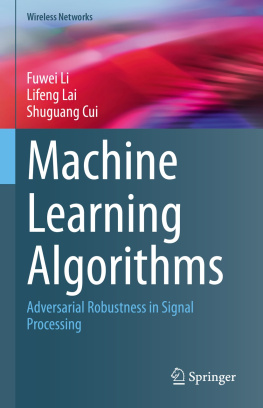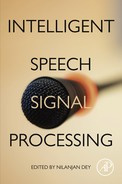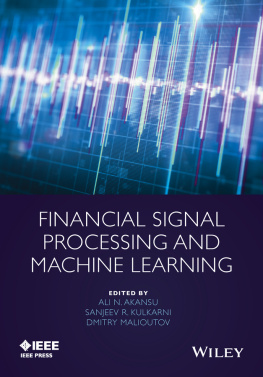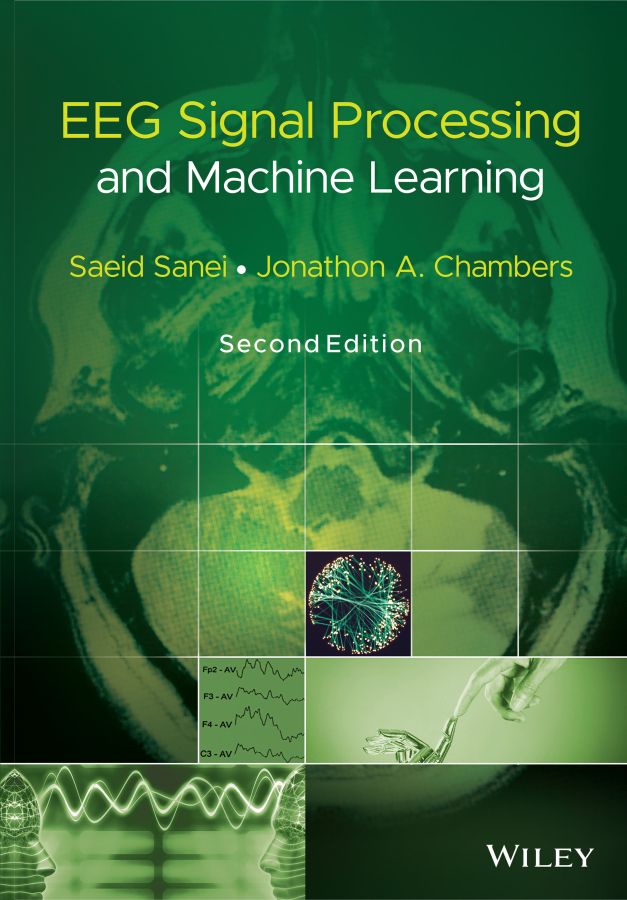
Table of Contents
List of Tables
- Chapter 5
- Chapter 9
- Chapter 10
- Chapter 12
- Chapter 18
List of Illustrations
- Chapter 1
- Chapter 2
- Chapter 3
- Chapter 4
- Chapter 5
- Chapter 6
- Chapter 7
- Chapter 8
- Chapter 9
- Chapter 10
- Chapter 11
- Chapter 12
- Chapter 13
- Chapter 14
- Chapter 15
- Chapter 16
- Chapter 17
- Chapter 18
Guide
Pages
EEG Signal Processing and Machine Learning
Second Edition
Saeid Sanei
Imperial College London & Nottingham Trent University, UK
Jonathon A. Chambers
University of Leicester, UK

This second edition first published 2022
2022 John Wiley & Sons Ltd
Edition History
John Wiley & Sons, Ltd. (1e, 2007)
All rights reserved. No part of this publication may be reproduced, stored in a retrieval system, or transmitted, in any form or by any means, electronic, mechanical, photocopying, recording, or otherwise, except as permitted by law. Advice on how to obtain permission to reuse material from this title is available at http://www.wiley.com/go/permissions.
The right of Saeid Sanei and Jonathon A. Chambers to be identified as the authors of this work has been asserted in accordance with law.
Registered Offices
John Wiley & Sons, Inc., 111 River Street, Hoboken, NJ 07030, USA
John Wiley & Sons Ltd, The Atrium, Southern Gate, Chichester, West Sussex, PO19 8SQ, UK
Editorial Office
The Atrium, Southern Gate, Chichester, West Sussex, PO19 8SQ, UK
For details of our global editorial offices, customer services, and more information about Wiley products visit us at www.wiley.com.
Wiley also publishes its books in a variety of electronic formats and by printondemand. Some content that appears in standard print versions of this book may not be available in other formats.
Limit of Liability/Disclaimer of Warranty
In view of ongoing research, equipment modifications, changes in governmental regulations, and the constant flow of information relating to the use of experimental reagents, equipment, and devices, the reader is urged to review and evaluate the information provided in the package insert or instructions for each chemical, piece of equipment, reagent, or device for, among other things, any changes in the instructions or indication of usage and for added warnings and precautions. While the publisher and authors have used their best efforts in preparing this work, they make no representations or warranties with respect to the accuracy or completeness of the contents of this work and specifically disclaim all warranties, including without limitation any implied warranties of merchantability or fitness for a particular purpose. No warranty may be created or extended by sales representatives, written sales materials, or promotional statements for this work. The fact that an organization, website, or product is referred to in this work as a citation and/or potential source of further information does not mean that the publisher and authors endorse the information or services the organization, website, or product may provide or recommendations it may make. This work is sold with the understanding that the publisher is not engaged in rendering professional services. The advice and strategies contained herein may not be suitable for your situation. You should consult with a specialist where appropriate. Further, readers should be aware that websites listed in this work may have changed or disappeared between when this work was written and when it is read. Neither the publisher nor authors shall be liable for any loss of profit or any other commercial damages, including but not limited to special, incidental, consequential, or other damages.
Library of Congress CataloginginPublication Data
Names: Sanei, Saeid, author. | Chambers, Jonathon A., author. | John Wiley & Sons, publisher
Title: EEG signal processing and machine learning / Saeid Sanei, Jonathon A. Chambers.
Description: Second edition. | Hoboken, NJ : Wiley, 2021. | Includes bibliographical references and index.
Identifiers: LCCN 2021003276 (print) | LCCN 2021003277 (ebook) | ISBN 9781119386940 (hardback) | ISBN 9781119386926 (adobe pdf) | ISBN 9781119386933 (epub)
Subjects: LCSH: Electroencephalography. | Signal processing. | Machine learning.
Classification: LCC RC386.6.E43 S252 2021 (print) | LCC RC386.6.E43 (ebook) | DDC 616.8/047547dc23
LC record available at https://lccn.loc.gov/2021003276
LC ebook record available at https://lccn.loc.gov/2021003277
Cover Design: Wiley
Cover Image: Andrea Danti/Shutterstock, imaginima/iStock/Getty Images, xijian/iStock/Getty Images, Marmaduke St. John/Alamy Stock Photo
Preface to the Second Edition
Brain research has reached a considerable level of maturity due, for example, to having access to: a wealth of recording and screening resources; availability of substantial data banks; advanced data processing algorithms; and emerging artificial intelligence ( AI ) for making more accurate clinical diagnosis. Neurotechnology is also now being exploited to design revolutionary interfaces to guide artificial prostheses for human rehabilitation. Moreover, the technology for brain repair, communications between live and AIbased body parts, mind reading, and intelligent recordings together with the use of virtual and augmented reality domains is advancing remarkably. The advances in brain research will soon make the Internetofbrains feasible and enable fully monitoring the body for personal medicine purposes.
To progress this fastgrowing technology, the demand for electroencephalography ( EEG ) data, as a widely accessible, informative, flexible, and expandable brain screening modality, together with suitable approaches in EEG processing, is rising dramatically.
Automatic clinical diagnosis requires signal processing and machine learning algorithms to bring more insight into interpretation of the data, devising a treatment plan, and defining the path for achieving personalized medicine which is the goal of future healthcare systems. EEG is of particular interest to researchers due to its very rich information content and its relation to the entire body function.
EEG signals represent three fundamental activities in the brain: firstly, they show the normal brain rhythms which exist in the EEGs of healthy subjects and indicate the human states such as awake and sleep; secondly, they demonstrate the brain responses to audio, visual, and somatosensory excitations, whose variations can represent the brain performance in the cases of mental fatigue, learning, and memory load; and thirdly, the communications between various brain zones which can change due to ageing, dementia, and many other factors. The study of these three aspects of EEG is the focus of this book.
Most of the concepts in single channel or multichannel EEG signal processing have their origin in distinct application areas such as communication, seismic, speech and music signal processing. EEG signals are generally slowvarying waveforms and therefore, similar to many other physiological signals, can be processed online without much computational effort.
This second edition of the book EEG Signal Processing, first published in 2007, highlights the major impact machine learning is now having on EEG analysis. This has been made possible by the recent developments in data analysis: firstly, due to the availability of supercomputers, powerful graphic cards, large volume computer clusters, and memory space within the public cloud, and secondly, due to introducing powerful classification algorithms such as deep neural networks ( DNNs ) which are suitable for numerous applications in braincomputer interfacing, mental task evaluation, brain disorder/disease recognition, and many others.
Next page

